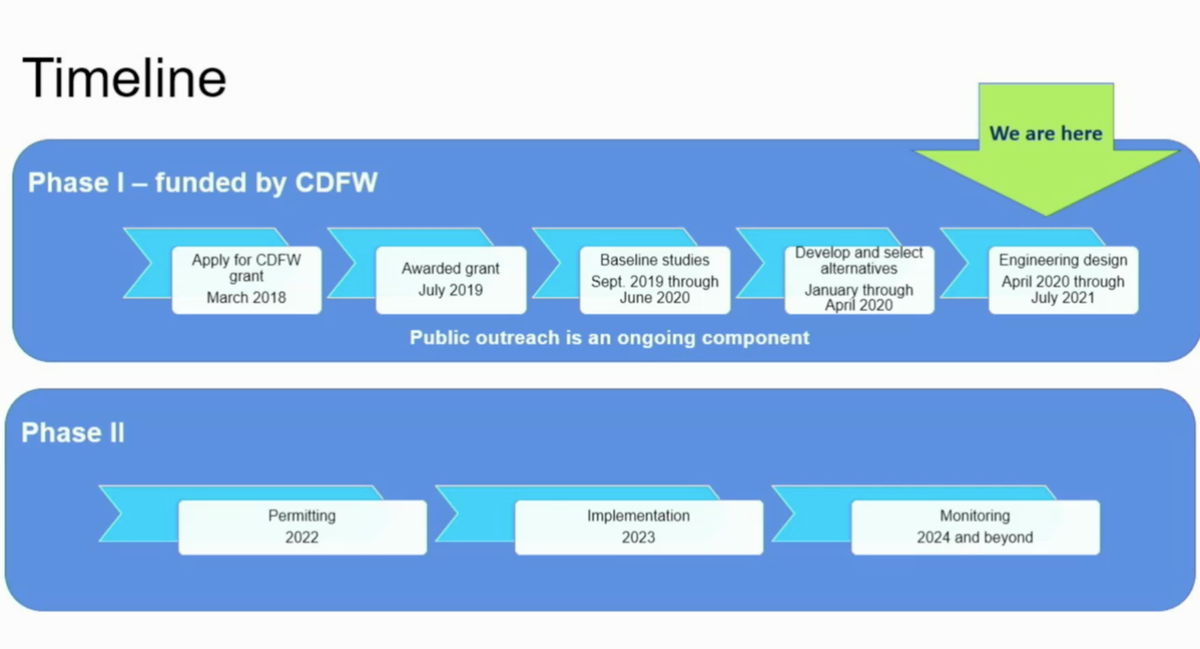Oakdale City Council members unanimously approved moving forward with Phase II of the Stanislaus River Salmonid Habitat Restoration Project at Monday night’s council meeting, April 5, which will put an additional $361,400 of grant funding into play for the extensive project.
According to city documents, in 2018-2019, the City of Oakdale was awarded a grant through the California Department of Fish and Wildlife (CDFW) in the amount of $341,036 to financially support and assist the implementation of the Stanislaus River Salmonid Habitat Restoration Project (River Restoration Project) at the Stanley Wakefield Wilderness Area. These grant funds were to be utilized to fund the efforts to provide baseline data and analysis for 100 percent design plans that would ultimately lead to the enhancement and restoration of up to 28 acres of channel, floodplain and upland habitats.
The City partnered with Cramer Fish Sciences to complete Phase I of the salmonid habitat restoration project, which included pre-project data collection, conceptual design development, stakeholder outreach, and ultimately a final design plan set. Phase II and III include environmental permitting, implementation (construction), and post-project monitoring.
Phase II will excavate perched floodplain, will create three to four spawning riffles/rearing habitat, and reduce habitat for predatory fish. The majority of the funding will go to implementation of on the ground restoration of the habitat. Part of the funding will go towards required environmental permitting and compliance and no General Fund money will be needed to complete Phase II of the River Restoration Project.
Phase III will consist of restoration of up to 28 acres of channel, floodplain and upland habitats and will need additional federal or state funds to be completed.
“This project has the potential of undoing 100 years of damage and put us in the state that’s not only good for fish but also so that the city and the residents can enjoy it and make it part of its amenities,” Cramer Fish Sciences representative Rocko Brown shared with council members.
As per the presentation, additional benefits include:
A more natural and restored ecosystem for the residence of Oakdale;
Compatible with the Stanislaus River Corridor Access Plan as part of the 2030 general plan;
Ability to leverage outside funding;
Creation of 10 acres of seasonal rearing habitat for juvenile Chinook salmon and steelhead;
Enhance wetland with ancillary benefits to native flora and fauna including western pond turtles and egrets;
Invasive vegetation removal of Himalayan blackberry and giant reed;
Increased inundation frequency will also promote natural recruitment of native vegetation such as cottonwoods.
City Manager Bryan Whitemyer agreed, saying of the current overgrowth obscuring the river’s edge, “Right now you have to be really good at crawling through blackberry bushes … it’s truly a jewel that we have that is underutilized.”
The finished restoration project would transform the recreational opportunities at Kerr Park into an oasis of beautiful riverside property as well as an educational environment for students similar to Knights Ferry with the protected salmon habitat.
“I think this sounds amazing,” Councilwoman Ericka Chiara said.
Councilman Curtis Haney expressed concern that accepting federal funds for the project might create unforeseen problems for businesses and suggested tabling the item until more research could be done into the funding parameters. Council decided it was unlikely any future or current businesses would be negatively affected by the restoration project and voted to accept the grant funds.
One member of the public voiced a concern about the potential of increased traffic to the Kerr Park area. Council agreed to increase police patrol in the area to ensure public safety.
The timeline for Phase II of the project stretches into 2024.





